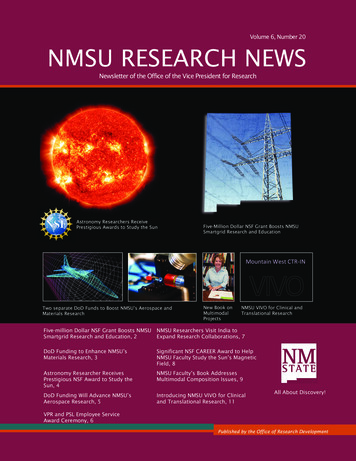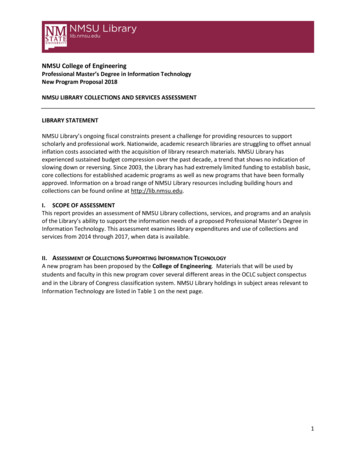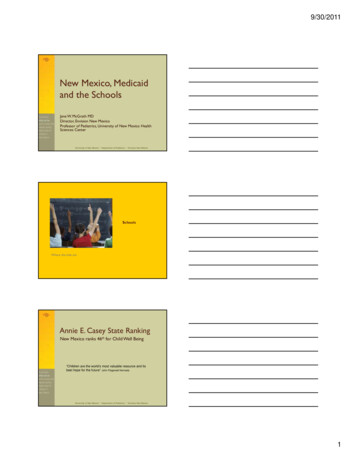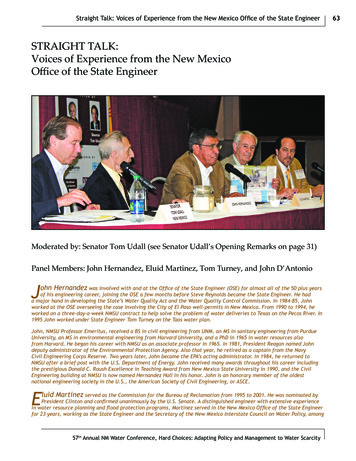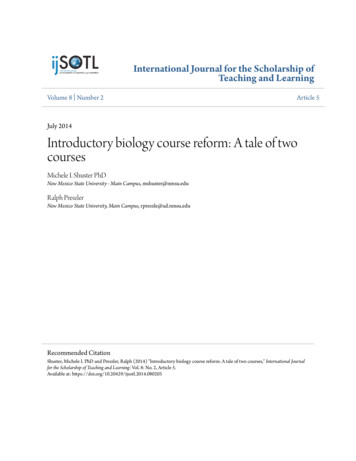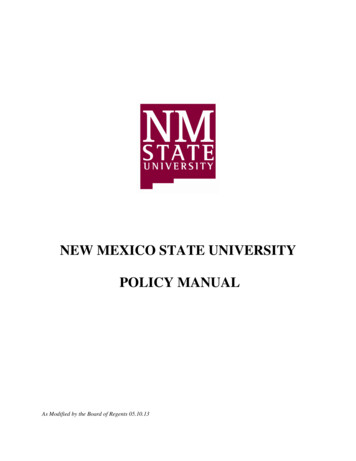
Transcription
NEW MEXICO STATE UNIVERSITYPOLICY MANUALAs Modified by the Board of Regents 05.10.13
TABLE OF CONTENTSINTRODUCTION .CHAPTER 1Governance Authority, Organizational Structure, and Policy Development and Approval . 1CHAPTER 2General Operating Policies . 2CHAPTER 3Employee, Student and Visitor Codes of Conduct . 3CHAPTER 4Human Resources - General Policies . 4CHAPTER 5Human Resources-Faculty Policies . 5CHAPTER 6Academic - Related Policies. 6CHAPTER 7Human Resources-Employee Benefits . 7CHAPTER 8Human Resources-Staff Policies . 8CHAPTER 9Facilities and Services . 9APPENDICES . A
IntroductionNew Mexico State University was founded in 1888 as Las Cruces College. The Territorial Legislature of 1889established the land-grant Agricultural College and Experiment Station, which officially opened on January 21,1890. During its first full academic year, the college became known as the New Mexico College of Agriculture andMechanic Arts, the first degree granting institution in the Territory. Under the provisions of the Morrill Act of 1862and subsequent federal legislation, the special mission of land-grant institutions has been to provide a liberal andpractical education for students and to sustain programs of research, extension education, and public service.In 1960, New Mexico College of Agriculture and Mechanic Arts became New Mexico State University. Since thattime, while sustaining excellence in those programs traditionally associated with land-grant institutions, NewMexico State has become a comprehensive doctoral level university offering a wide variety of programs through theGraduate School and the colleges: Agriculture and Home Economics, Arts and Sciences, Business Administrationand Economics, Education, Engineering, and Health and Social Services.New Mexico State University is the state’s land-grant university, serving the educational needs of New Mexico’sdiverse population through comprehensive programs of education, research, extension education, and public service.The New Mexico Constitution establishes New Mexico State University as one of the state’s post secondaryeducational institutions, and requires the legislature to provide for the control and management of the institutionthrough a five member Board of Regents, which serves as the governing body for both New Mexico State Universityas well as for the New Mexico Department of Agriculture. (See Appendix 1-A for a partial listing and description ofrelevant constitutional and statutory provisions.)
NMSU Policy ManualChapter 2 Page 1 of 15Chapter 1Governance Authority, Organizational Structureand Policy Development and Approval1.05Governance/Authority/Organizational 01.05.701.05.801.05.851.05.901.05.951.05.96Board of Regents BylawsBoard of Regents - Other PoliciesPresident of New Mexico State UniversityOrganizational Chart (See Appendix 1-C)University Administrative CouncilAcademic Deans CouncilFaculty Senate (See also Appendix 1-D for Constitution)NMSU Employee Council (See also Appendix 1-E for Constitution, Bylaws)Associated Students of NMSU (ASNMSU)University BoardsNMSU Community Colleges (See also subject matter headings such as Promotion, Tenure)Community College Faculty Council1.10Policy Development and Approval1.15Non-Academic Units-Creating, Reorganizing, Relocation, Eliminating1.20Gender Equity Policy and Statement of Principles
NMSU Policy ManualChapter 2 Page 2 of 15CHAPTER 1 - GOVERNANCE AUTHORITY, ORGANIZATIONAL STRUCTURE ANDPOLICY DEVELOPMENT AND APPROVAL1.05Governance/Authority/Organizational Structure1.05.10Board of Regents Bylaws [Amended by Board of Regents 09.26.08][Amendment adopted byAdministrative Council 04.14.09; ratified by the Board of Regents 07.29.09]A. ARTICLE I - Membership of the Board of Regents:1.Name: The name of the board shall be The Board of Regents of New Mexico StateUniversity.2.Membership, Appointment, Qualifications and Terms of Members; Removal andReplacement: The membership, appointment, qualifications and terms of the members of theboard and their removal and replacement shall be governed by the constitution and laws of thestate of New Mexico.3.Student Member: The governor shall nominate and by and with the consent of the senateshall appoint a student member to serve a 2-year term. The governor shall select, with theadvice and consent of the senate, a student member from a list provided by the president ofthe institution. In making the list, the president of the institution shall give due considerationto the recommendations of the student body president of the institution. (Laws of 1993 Constitutional Amendment 3)B. ARTICLE II - Ex Officio Members of the Board of Regents:1.Statutory Members: The board shall consist of such statutory regular and ex officio membersas provided by law.2.Faculty Representative: At the pleasure of the board, the chair of the Faculty Senate shallserve as the faculty, ex officio, nonvoting representative on the board.3.Student Representative: At the pleasure of the board, the president of the Associated Studentsof New Mexico State University (“ASNMSU”) shall serve as the student, ex officio,nonvoting representative on the board. The ASNMSU president’s designee may serve in thiscapacity if the ASNMSU president is unable to attend a meeting of the board.C. ARTICLE III - Meetings of the Board of Regents:1.Compliance with Sunshine Laws: All meetings of the Board of Regents shall be conducted incompliance with the New Mexico Open Meetings Act, NMSA 1978, § 10-15-1 et seq andwith the board’s Annual Resolution Establishing Notice. All records of the board shall beopen to inspection by the public at reasonable times, and in accordance with the New MexicoInspection of Public Records Act. NMSA 1978, § 14-2-1 et seq and with NMSA 1978, § 211-16.2.Regular Meetings: A minimum of five regular meetings of the board shall be held each yearon such dates, places and hours as may be fixed from time to time by the board.3.Special Meetings: Special meetings, normally reserved for matters that require action beforethe next regular meeting, may be called by the chair of the board or at the request of tworegents.4.Emergency Meetings: Emergency Meetings will be called only for unforeseen circumstancesthat demand immediate attention to protect the health, safety and property of citizens or toprotect the university from substantial financial loss. The Board of Regents will avoidemergency meetings whenever possible. Emergency meetings may be called by the chair ofthe board, or at the request of two regents.
NMSU Policy ManualChapter 2 Page 3 of 155.Telephonic Attendance at Meetings: Consistent with the Open Meetings Act, members of theboard shall be permitted to attend any meeting of the board by telephone, when it is otherwisedifficult or impossible for the member to attend the meeting in person, provided that eachmember participating by conference telephone can be identified when speaking, allparticipants are able to hear each other at the same time and members of the public attendingthe meeting are able to hear any member of the board who speaks during the meeting.6.Notice of Meetings: The board shall provide reasonable notice to the public of its regular,special and emergency meetings, in accordance with its Annual Resolution EstablishingNotice Requirements. The agenda for each meeting will be available no less than twenty-fourhours prior to the meeting. The meeting notice shall indicate how a copy of the agenda maybe obtained.7.Notice to Persons With Disabilities: In addition to the information specified above, all noticesshall include the following language:If you are an individual with a disability who is in need of a reader, amplifier,qualified sign language interpreter, or any other form of auxiliary aid or serviceto attend or participate in the meeting, please contact the Office of the Chief ofStaff at (575) 646-1727 at least three (3) calendar days prior to the meeting oras soon as possible. Public documents, including the agenda and minutes, canbe provided in various accessible formats. Please contact the Office of the Chiefof Staff at (575) 646-1727 if a summary or other type of accessible format isneeded.”8.Closed Meetings: The Board of Regents may close a meeting to the public only if the subjectmatter of such discussion or action falls within one of the exceptions in the Open MeetingsAct, § 10-15-1(H).a.b.c.d.9.If any meeting is closed during an open meeting, such closure shall be approved by amajority vote of a quorum of the board taken during the open meeting. The authority forthe closed meeting and the subjects to be discussed shall be stated with reasonablespecificity in the motion to close and the vote of each individual member on the motionto close shall be recorded in the minutes. Only those subjects specified in the motion maybe discussed in the closed meeting.If a closed meeting is conducted when the board is not in an open meeting, the closedmeeting shall not be held until public notice, appropriate under the circumstances, statingthe specific provision of law authorizing the closed meeting and the subjects to bediscussed with reasonable specificity is given to the members and to the general public.Following completion of any closed meeting, the minutes of the open meeting that wasclosed, or the minutes of the next open meeting if the closed meeting was separatelyscheduled, shall state whether the matters discussed in the closed meeting were limitedonly to those specified in the motion or notice for closure.Except as provided by Section 10-15-1(H) of the Open Meetings Act and New Mexicocase law interpreting same, any action taken as a result of discussions in a closed meetingshall be made by vote of the board in an open public meeting.Minutes: The board shall keep written minutes of its regular, special and emergency meetings.The law does not require minutes to be maintained for closed sessions. Any record kept of aclosed session shall not be subject to public inspection. Minutes shall state at a minimum thedate, time and place of the meeting; the names of the members in attendance and those absent;the substance of any proposals considered, and a record of any decisions and votes taken thatshow how each member voted. The minutes become official upon approval by the board. TheBoard of Regent’s chair signs the minutes on behalf of the Board of Regents.10. Agenda: The meeting agenda sets the order of Board of Regents’ business. A proposedagenda shall be prepared for each regular meeting of the board and mailed to each member atleast 5 days before the meeting. Any member of the board and the chair may, prior to thedeadline for public notice of the agenda, request placement of an item on the agenda. If anyindividual or group wishes to have an action item considered by the Board of Regents, allpertinent documentation must be submitted in advance of the meeting to the Office of the
NMSU Policy ManualChapter 2 Page 4 of 15President in order to allow for staff review. As necessary, the chair of the board or designeewill correspond with the individual or group to obtain additional information if needed, and toinform whether or not the item will be placed on the agenda. If the item is not placed on theboard’s agenda, the requestor will be informed regarding the opportunity to address the Boardof Regents during the time allotted for general public input.11. Quorum: A majority of the board shall constitute a quorum for the transaction of business,but a lesser number may convene from time to time until a quorum is in attendance.12. Rules of Order: Except where they may be in conflict with these bylaws, the Robert's Rulesof Order, revised, shall govern the conduct of the meetings of the Board.13. Attendance: Board of Regents members shall make every effort to attend all meetings of theboard.14. Compensation: Members of the Board of Regents are not remunerated for their services; theyare however, entitled to receive travel reimbursement.a.b.Travel Reimbursement: Travel reimbursement for board members shall be paid inaccordance with NMSU Business and Finance Policies and Procedures, consistent withthe New Mexico Mileage and Per Diem Act. (See Business Procedures Manual for allother current mileage and per diem rates)Insurance: The board authorizes the administration to annually secure travel accidentinsurance for appointed and ex officio members of the board and their legal spouses whiletraveling on university business at a total cost not to exceed 1,000 annually.D. ARTICLE IV - Officers of the Board of Regents:1.Election of Officers: The Board of Regents shall meet and elect officers at the March meetingof each year, unless a new member, or members, of the board have not been appointed by thegovernor in which case the election of officers shall be held at the first meeting followingsuch appointment. All officers so elected shall hold office until their successors are electedand qualified. At such elections they shall elect a chair, a vice chair, and a secretary-treasurerfrom their number. The chair and vice chair may also be referred to as the board’s presidentand vice president. Officers and members shall be covered under the New Mexico StateFaithful Performance Blanket Bond.2.Eligibility: Any member of the board shall be eligible for any office of the board; ex officiomembers are not eligible to hold any office on the board.3.Tenure and Vacancy: Each officer of the board shall be elected for a one-year term and shallserve until a respective successor is elected and qualifies. A vacancy in any of the abovedesignated offices, other than one caused by removal, shall be filled by election at the nextmeeting of the board following its occurrence, and if caused by removal, may be filled at thesame meeting at which the vacancy occurred. If because of a vacancy an officer of the boardis elected and qualifies for a different position on the board, acceptance of this election willconstitute resignation from the previous position. Election to a vacant office shall be for thebalance of the unexpired term.4.Duties of the Chair: The chair of the board shall perform such duties as devolve upon theoffice by law and which may be pertinent to the office. The chair of the Board of Regentsshall direct the president of the university to issue calls for all meetings of the Board ofRegents. The chair of the Board of Regents shall preside at its meetings, with full power tovote on and to second any motion, and to discuss all matters, with the same authority as anyother board member, not-withstanding any provision of the Robert's Rules of Order. Thechair of the Board of Regents shall sign the official minutes of all board meetings after theboard has approved them. The chair’s signature shall be affixed to all diplomas for degreesand all other documents requiring board approval. The chair of the Board of Regents shallperform such other duties as may be specified in these bylaws and as may be from time totime determined by the Board of Regents.
NMSU Policy ManualChapter 2 Page 5 of 155.Duties of the Vice Chair: In the absence or incapacity of the chair, the vice chair shall assumethe duties and obligations of the chair.6.Duties of the Secretary-Treasurer: The secretary-treasurer shall serve as the recordingsecretary for meetings of the board. The secretary-treasurer shall sign board minutes whenofficially approved. The secretary-treasurer’s signature shall be affixed to all diplomas fordegrees, and all other legal documents requiring board approval. The secretary-treasurer shallperform such other duties as the board may direct and require.E. ARTICLE V - Functions/Operating Principles of the Board of Regents:1.Functions of the Board of Regents:a.b.c.d.e.f.2.F.1.05.20To exercise control and management over the university and to exercise all other powers,authority, responsibilities, obligations, immunities and duties granted to it by law and theConstitution of New Mexico.To provide educational opportunity to prospective students, particularly those prospectivestudents residing in this state, and to provide a high quality education to all students ofthe university.To serve the interests of the students, faculty, and administration and the citizens of NewMexico, and to institute policies, facilities, and programs for their benefit.To obtain adequate financial support.To select a chief executive officer for the institution and the director/secretary of the NewMexico Department of Agriculture.To promulgate rules and regulations for the university and for the New MexicoDepartment of Agriculture: to enforce statutes, rules and regulations pertaining to theuniversity and to the New Mexico Department of Agriculture.Principles of Board Operation: The Board of Regents exercises its control over the institutionthrough its policies as administered by the administration. Decisions of the Board of Regentsshall be made by the board acting as a body in a duly constituted meeting; individualmembers of the board may, however, discuss the affairs of the university and obtaininformation pertaining thereto from any other members of the board and from any employeeor student of the university. Policies of the board shall be maintained in written form, butfailure to do so shall not affect their validity. A member of the board shall not be interestedpecuniarily, either directly or indirectly, in any contract for building or improvement of theuniversity, or for the furnishing of supplies, services or materials to said institution.Contributions to the university, in any form, by a member of the board are not in violation ofthese bylaws. No one member should enter into correspondence as a member of the board.This is a group operation and not an individual one; therefore, it is undesirable to have aletterhead specifically for the board. Any change in organization or structure of anysubdivision of this university from the level of dean and higher and any other organizationalchange which the administration deems of sufficient importance shall be approved by theboard before it is implemented.ARTICLE VI - Amendments:1.Amendments: The power to make, alter, amend, or repeal these bylaws is vested in the boardby the affirmative vote of at least 3 of its members.2.Notice of Amendments: Copies of proposed amendments shall be submitted to the Board ofRegents members at least 5 days prior to the meeting at which the proposal is to be actedupon, unless waived by unanimous consent of the board.Board of Regents - Other Policies [Amendment recommended by Administrative Council07.13.10; approved by Board of Regents 07.20.10][Amendment recommended by AdministrativeCouncil 04.09.13; approved by Board of Regents 05.10.13]
NMSU Policy ManualChapter 2 Page 6 of 15A. NMSU Foundation, Inc.: The Board of Regents shall elect one of its members to serve on theboard of directors of the NMSU Foundation, Inc. during the annual election of officers in evennumbered years.BArrowhead Center, Inc.: Annually, the board shall also name two of its members to the board ofdirectors of the Arrowhead Center, Inc, formerly called the NMSU Technology TransferCorporation, Inc., and as merged with the NMSU Research Park Corporation, Inc.C. Regents’ Committees: The Board of Regents may establish regents’ committees to assist it infulfilling statutory and fiduciary obligations to New Mexico State University and to the NewMexico Department of Agriculture. A regents’ committee may be comprised of no more than twovoting regents, appointed by the chair, and any other individual(s) appointed by the Board.Regents’ committees are distinct from university boards addressed in Policy 1.05.90. Regents’committees include, but are not limited to: the Regents’ Budget Committee, the Regents’ AuditCommittee, and the Regents’ Real Estate Committee. (See Appendix 1-G.)D. Regents’ Medal: The Regents’ Medal shall be awarded on suitable occasions and with appropriateceremonies to persons who have made outstanding contributions to the university, to the State ofNew Mexico, or to the United States. Documented nominations may come from any group orindividual, through the administration, for consideration for this honor by the board.E. Autonomy of Regents: The local autonomy of each Board of Regents should be strengthened andthe number of regents on each board should remain the same. The board opposes any super Boardof Regents or one central board of operation; further, the New Mexico Higher EducationDepartment should be purely a coordinating financial review body and not involved in any kind ofday-to-day business or administration of the university.1.05.30President of New Mexico State University [Amended by the Board of Regents 07.29.09]A. Delegation of Authority: The president is the chief executive officer and is directly responsible tothe Board of Regents for the overall programs of the university. The president is responsible forexecution of such measures as the board may enact regarding administration of all approvedmeasures presented by the Faculty Senate or the various councils; however, the president maydelegate administration of these matters. The president’s further delegation of the board’sauthority to other appropriate administrators, for the purpose of institutional efficiency, will bedocumented and be available for viewing on line at: Signature Authority Table 2010.B. Personnel Administration: The employment, advancement, and dismissal of all administrators,faculty, and other university personnel are delegated to the president and to whomever thepresident delegates such authority.C. Role of EVP/Provost: The executive vice president and provost serves as the chief administrativeofficer in the absence of the president.D. Board’s Role in Personnel Matters: Although the board should never actively nor directlyparticipate in the actual hiring of university personnel, with the exception of the president and thedirector/secretary of the New Mexico Department of Agriculture, the board should always be atliberty to review any particular hiring by the administration, to determine compliance with theboard’s hiring policies.E. Operational Authority: The board delegates authority for the internal management of theinstitution to the president. All key policy decisions are made by the president in consultationwith the appropriate administrators. All administrators serve at the pleasure of the president. Thepresident is authorized to sign contracts for the university, on behalf of the Board of Regents.1.05.40Organizational Chart (See Appendix 1-C)1.05.50University Administrative Council [Amended by Board of Regents 09.08.06][Amendmentrecommended by Administrative Council 12.14.10; approved by Board of Regents 01.31.11]
NMSU Policy ManualChapter 2 Page 7 of 15A. Recognition of Council and Purpose: The Board of Regents recognizes the UniversityAdministrative Council as an advisory body, to be utilized at the university president’s discretion,for discussion and/or recommendations on matters of university business.B. Membership of Council: At the discretion of the university president, the membership includes theexecutive vice president and provost, senior vice presidents, community college presidents, vicepresidents, associate vice presidents, athletics director, deans, faculty senate chair, ASNMSUpresident, graduate student council president, chair of the Employee Council, university generalcounsel, chief audit executive (ex officio) and others as may be invited by the president.C. Conduct of Meetings: The university president chairs the University Administrative Council. Inthe president's absence, the executive vice president and provost acts in this capacity. Minutes ofeach meeting will be distributed to the council members prior to the next meeting, or as soon aspracticable.1.05.60Academic Deans CouncilA. Recognition and Purpose: The functions of the Academic Deans Council are as follows:1.Provide an administrative vehicle for the dissemination of information, provide ready poolingof ideas, and provide a testing ground for the matters of concern to the administration of theuniversity.2.Make recommendations and discuss with the president problems relating to improvement inthe administration of the institution.3.Act as a sounding board and evaluation body for new ideas emanating from the staff oradministration.4.Consider ways and means of improving the academic quality and other aspects of theinstitution, including proposals dealing with academic policies and programs.5.Coordinate efforts of the various deans and provide for desirable uniformity in carrying outinstitutional policy.6.Provide administration-level coordination between the various agencies, colleges, and schoolsof the university.7.Stimulate other official groups in the full development of action within respective areas.8.Establish, from time to time, special committees and groups to render specialized service indeveloping recommendations in given areas.9.Consider recommendations emanating from the NMSU Employee Council when appropriate.B. Membership: The Academic Deans Council is composed of the president, the executive vicepresident and provost, the vice president for research, the academic deans, the dean of theuniversity Library, the community colleges campus executive officers, and the chair of the FacultySenate.1.05.70Shared Governance and the Role of the Faculty Senate [Amendment (FS Proposition07-10/11A) passed by Faculty Senate 01.13.11 and 03.03.11 as amended; recommended byAdministrative Council 03.09.11; approved by Board of Regents 08.22.11]A. Shared Governance: Shared governance refers to the governance of the university in whichresponsibility is shared among the Board of Regents, the faculty and the administration. As usedin this policy, “faculty” refers to the general faculty, defined as all tenured, tenure track andcollege faculty at all of the university’s campuses. For purposes of this policy, the universitypresident and the executive vice president and provost, and their respective direct reports, shall becollectively referred to as “administration”. Shared governance shall remain a central tenet of
NMSU Policy ManualChapter 2 Page 8 of 15academic decision making at New Mexico State University.1.By law, the Board of Regents governs the NMSU system, under the advice of faculty, by theenactment of policies and by its delegation of operational authority through the universitypresident.2.Consistent with the principles of the American Association of University Professors (AAUP),the faculty, represented through the Faculty Senate and other faculty representatives, shall beinvolved in personnel decisions, selection of administration, preparation of budget, anddetermination of educational policies. The faculty shall have primary responsibility forcurriculum and subject matter and methods of instruction, research, faculty status and thoseaspects of student life which related to the educational process. Faculty shall have primaryresponsibility for developing and applying policies affecting the university’s academicmission in regard to education, research, and service, subject to the authority of the Board ofRegents, the university president, and the executive vice president and provost.3.The faculty shall also be involved in administrative planning processes. To facilitate this,faculty members serve on the many and varied administrative committees.a.b.c.The chair of the Faculty Senate shall be a member of the Academic Deans Council and ofthe Administrative Council.The vice chair of the Faculty Senate shall be a member of the Associate Deans AcademicCouncil.As directed by administration, members of the general faculty serve on other advisorycommittees, including but not limited to: the University Budget Committee, theUniversity Research Council, and the President's Associates Board. Moreover, theFaculty Senate may select the requisite faculty representative; in addition, administrationmay select a member of the faculty directly.B. Faculty Senate: The Faculty Senate has legislative jurisdiction over policies affecting theuniversity’s academic mission in regard to education, research, and service, including thedefinitions of purpose and objectives. The Faculty Senate is elected by the faculty at large. TheFaculty Senate Constitution provides specifications relating to the Faculty Senate’s composition,elections, terms of office, officers, committees, meetings, legislative processes, and methods toamend the constitution. See Appendix 1-D. Additional details about the operation of the FacultySenate are contained in the Faculty Senate Bylaws. The chair o
In 1960, New Mexico College of Agriculture and Mechanic Arts became New Mexico State University. Since that time, while sustaining excellence in those programs traditionally associated with land-grant institutions, New Mexico State has become a comprehensive doctoral level university offering a wide variety of programs through the

